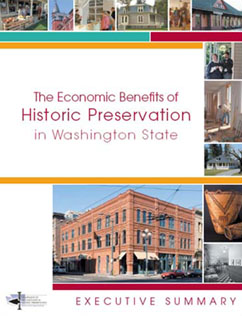Economic Benefits
 The cultural and historic resources of a community tell the story of its past and make any single community distinct from other places. These resources provide tangible connections to the people and events that have shaped our communities and our collective histories. Preserving the physical reminders of our past creates a sense of place and community pride. Historic preservation also generates a wide range of economic benefits in Washington State. Economic benefits include those associated with the rehabilitation and adaptive reuse of historic buildings and heritage tourism, as well as the impacts that historic designation has on neighborhood character and property values. Other benefits include the role that historic preservation plays in economic development and downtown revitalization.
The cultural and historic resources of a community tell the story of its past and make any single community distinct from other places. These resources provide tangible connections to the people and events that have shaped our communities and our collective histories. Preserving the physical reminders of our past creates a sense of place and community pride. Historic preservation also generates a wide range of economic benefits in Washington State. Economic benefits include those associated with the rehabilitation and adaptive reuse of historic buildings and heritage tourism, as well as the impacts that historic designation has on neighborhood character and property values. Other benefits include the role that historic preservation plays in economic development and downtown revitalization.
The overall impacts documented in these reports, which are often presented in terms of jobs, income, and tax revenues, are conservative, in that they do not portray the full extent of the economic impacts that historic preservation has on the State and local communities. The focus of our analysis is on three key aspects of historic preservation and does not capture all the economic benefits associated with preservation activities ongoing throughout the state. In addition, our analysis focuses primarily on dollar-related impacts and jobs, income, and tax revenues. It does not address other forms of preservation activity—such as the work of volunteers—that are less easy to quantify, but nevertheless, provide economic and other benefits to local communities and the state as a whole.
In 2006, the Department of Archaeology and Historic Preservation (DAHP) completed its research to document the economic impact of historic preservation on Washington's economy. This research effort focuses on three key aspects of economic impacts: rehabilitation of historic buildings, heritage tourism, and the effects of historic district designation on property values. In addition, data is presented on the economic impacts of the Washington State Main Street Program. The products of this effort is three reports: the six page Executive Summary, the 15 page Summary Report, and the 81 page Technical Report. Of the three, only the Executive Summary is also available in hard copy format, copies of which can be obtained by contacting DAHP. The Summary and Technical reports are only available in electronic format.
Economic Benefit Reports
Older, Smaller, Better - Measuring how the character of buildings and blocks influences urban vitality - National Trust Study
 All across America, blocks of older, smaller buildings are quietly contributing to robust local economies and distinctive livable communities. This groundbreaking study demonstrates the unique and valuable role that older, smaller buildings play in the development of sustainable cities. Building on statistical analysis of the built fabric of three major American cities, the research demonstrates that established neighborhoods with a mix of older, smaller buildings perform better than districts with larger, newer structures when tested against a range of economic, social, and environmental outcome measures.
All across America, blocks of older, smaller buildings are quietly contributing to robust local economies and distinctive livable communities. This groundbreaking study demonstrates the unique and valuable role that older, smaller buildings play in the development of sustainable cities. Building on statistical analysis of the built fabric of three major American cities, the research demonstrates that established neighborhoods with a mix of older, smaller buildings perform better than districts with larger, newer structures when tested against a range of economic, social, and environmental outcome measures.
The Report
Main Street's Impact in Washington State: 2011-2019 - Washington Main Street Program
Washington's Main Street Communities transform their neighborhoods, celebrate historic character, and revitalize local economies. The purpose of this report is to quantify the positive return on investment Main Streets provide their public, private, and nonprofit partners and tell a complete story about the vital role they play in their communities. This report summarizes the range of programming and responsibilities assigned to these local Main Street organizations, describes their most common activities, and assesses the impacts these functions have on their local economy, residential community, and the State of Washington. The study analyzes the impacts of eight different Main Street initiatives between 2011 and 2019.
The Report
Other Studies
- Historic Preservation and Residential Property Values: An Analysis of Texas Cities
- Donovan Rypkema Lecture - 2012 National Trust Meeting in Spokane
- Measuring Economic Impacts of Historic Preservation - Donovan Rypkema
- Investing in Michigan's Future: the Economic Benefits of Historic Preservation
- Economic Impacts of Historic Preservation in Massachuttes
- Economic Benefits of Historic Preservation Activities in Pennsylvania
- Profits Through Preservation: The Economic Impact of Historic Preservation in Utah
- Affordable Housing and Historic Preservation (Powerpoint presentation from Planners Assoc. of Washington Conference in 2019)




